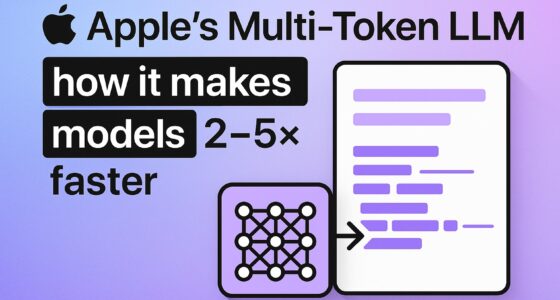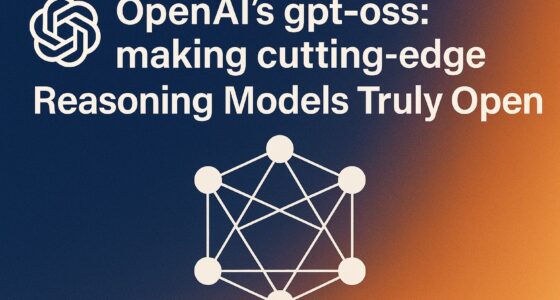This briefing document summarizes the current landscape of the AI model wars, focusing on the strategic positions, strengths, weaknesses, and potential future trajectories of the three key players: OpenAI, Google, and Apple. It highlights the main themes of competition, innovation, and market disruption, drawing key facts and direct quotes from the provided source.
1. Executive Summary
The AI industry is undergoing a rapid transformation driven by an intense three-way competition between OpenAI, Google, and a newly entering Apple. OpenAI, with its strategic partnership with Microsoft, leads in enterprise adoption and developer ecosystem dominance, characterized by aggressive pricing and continuous model advancements. Google has launched a “surprise counter-attack” by democratizing advanced AI reasoning with its Gemini 2.5 Deep Think model, making it widely accessible at a low cost. Apple, despite its financial strength and engineering talent, faces significant challenges due to its “privacy-first approach” and a perceived lag in AI capabilities, prompting questions about its survival in this rapidly evolving landscape. The broader implications of this battle include shifting consumer expectations, geopolitical competition for technological leadership, and significant disruption for traditional software companies.
2. Key Players and Their Strategies
2.1 OpenAI: Building the Operating System for AI
OpenAI, in partnership with Microsoft, has positioned itself as a dominant force, essentially “building the operating system for artificial intelligence.”
- Strategic Deployment and Model Innovation: OpenAI consistently pushes the boundaries of AI capabilities. They “routinely release advanced models to small groups of users, gathers real-world performance data, then pulls them back before competitors can reverse-engineer their capabilities.” Examples include “GPT5 new proxy API EV3,” which offered “coding assistance that understands context across multiple files, suggests architectural improvements, and writes documentation that reads like it came from a senior engineer.” Their rumored 120 billion parameter open-source model, potentially “near-GPT-4 quality,” could allow companies to “run advanced AI models locally without sending sensitive data to external servers.”
- Microsoft Partnership & Infrastructure Scale: The collaboration with Microsoft is a “strategic masterstroke,” providing “Azure’s global infrastructure” and “computing resources that would cost competitors billions to replicate.” Microsoft’s “enterprise sales force integrates AI models into comprehensive cloud packages for Fortune 500 companies.”
- Aggressive Pricing: OpenAI has “slashed API costs by roughly 75% over the past year while simultaneously improving model quality,” forcing competitors into “a price war they can’t win.”
- Multimodal Expansion and Safeguards: Their vision extends beyond text, with “voice capabilities produce speech that’s indistinguishable from human conversation” and “vision integration processes images with accuracy that matches human performance.” They also prioritize safeguards, with models refusing “to generate harmful content, explain their reasoning process, and admit when they’re uncertain about answers,” attracting enterprise customers.
- Developer Ecosystem: With “over three million developers” building on their APIs, OpenAI has cultivated a strong “network effect,” making their platform “the obvious choice for new AI projects.”
2.2 Google: The Surprise Counter-Attack and Democratization of Advanced AI
Google has made an “audacious move in AI history” by democratizing access to its advanced reasoning model, Gemini 2.5 Deep Think, through affordable consumer subscriptions.
- Deep Think Breakthrough: Gemini 2.5 Deep Think “generates multiple solution paths in parallel, refines them, then delivers the best answer—mirroring how human experts work.” It “surpasses previous Gemini versions on math, coding, and reasoning benchmarks—achieving a meaningful step-change in AI reasoning capabilities.”
- Massive Computational Infrastructure: Google’s “massive computational infrastructure” and “global network of data centers” are crucial for training and deploying these resource-intensive models.
- Unmatched Data Advantage: Their “integration across Search, YouTube, Android, and Cloud services creates an unmatched data advantage,” forming a “flywheel effect where better AI improves their services, attracts more users, and generates more data for even better AI.”
- Affordable Consumer Pricing: Making Deep Think “available to regular consumers through affordable subscriptions democratizes access to capabilities that were previously reserved for enterprise customers.” This “creates a new generation of AI-powered applications.”
- Research Culture and Advertising Revenue: Google’s “academic partnerships and commitment to open research” ensure continuous innovation. Their “advertising revenue model creates a strategic advantage” by allowing them to “subsidize AI development using profits from their advertising business.”
- Platform Dominance: Google is “using their platform dominance to make advanced AI ubiquitous and accessible,” transforming AI “from a premium service into a standard utility.”
2.3 Apple: The Desperate Scramble and Privacy Handicap
Apple has “officially entering the AI model wars,” but faces “steep hurdles catching up to peers,” with its “AI capabilities lag significantly behind both OpenAI and Google.”
- Privacy-First Handicap: Apple’s “privacy-first approach has become their biggest strategic handicap.” Unlike competitors who leverage “massive, diverse datasets,” Apple’s “strict on-device processing limits its data pool,” resulting in AI systems that “learn from limited, sanitized datasets that can’t compete with the real-world complexity their rivals access.”
- Internal Cultural Resistance: “Internal culture sources describe tension between hardware and software priorities,” with AI projects potentially de-prioritized in favor of “new iPhone features.”
- External Partnerships (ChatGPT Integration): Apple has “reportedly explored external partnerships to boost Siri’s smarts, including potential ChatGPT integration.” This indicates a need for “external help to keep up with basic user expectations,” creating “long-term risks because Apple loses control over a core component of its user experience.”
- Walled Garden Data Limitation: Apple’s “walled garden limits training data variety,” turning its “ecosystem advantage in user experience becomes a data disadvantage in AI development.”
- On-Device vs. Server-Scale Compute: While Apple’s silicon is efficient for “on-device tasks,” it “can’t deliver frontier reasoning without server-scale compute,” limiting its capabilities compared to rivals who leverage massive server farms.
- Financial Pressure and Project Underperformance: Apple faces pressure to “invest billions in AI development while maintaining their industry-leading profit margins.” Leaked information suggests “consistent underperformance compared to their ambitious goals,” with “multiple projects have been canceled or significantly scaled back.”
3. Broader Implications of the AI Model Wars
The competition among these tech giants is reshaping the entire technology industry, creating new challenges and opportunities.
- Ecosystem Lock-in: Companies and developers face a critical decision: “which AI ecosystem will they build their future on?” This choice “determines their technical capabilities, pricing structure, and competitive positioning for years to come,” as “developers often find it difficult to switch later.”
- Evolving Consumer Expectations: “Advanced AI capabilities transform from luxury features into basic requirements.” Google’s Deep Think release exemplifies this, making “advanced reasoning capabilities that would have cost thousands of dollars in enterprise contracts just months ago are now accessible to anyone.”
- Geopolitical Implications: The race for AI leadership has “geopolitical implications,” with American companies competing against international rivals. “The country that controls the fundamental AI infrastructure gains enormous influence over international commerce, national security, and technological standards worldwide.”
- Disruption for Traditional Software Companies: “AI-native startups can outpace legacy vendors by shipping intelligent features in weeks, not years.” Established businesses must “completely rethink their value proposition” and “embrace AI-first thinking.”
- Winner-Take-All Dynamics for Startups: Smaller companies “must choose one ecosystem and hope their selected platform emerges victorious,” leading to “concentrated power among the few companies that control the underlying AI infrastructure.”
- Democratization of Capabilities: The competition “drives down costs and increases accessibility,” making advanced “AI tools that required massive computational resources and specialized expertise now work through simple web interfaces.” This “enables innovation across industries that never had access to advanced technology before.”
4. Conclusion: The Defining Battlegrounds
The future of technology will be determined by which companies control the underlying AI infrastructure. The “strategic decisions happening right now will determine which companies control the infrastructure that powers tomorrow’s technology.”
The three critical battlegrounds are:
- Model Quality: The continuous innovation and advancement of AI models.
- Data Ecosystems: The breadth and quality of data available for training.
- Infrastructure Scale: The computational power and global reach to deploy and serve models.
OpenAI’s “enterprise dominance,” Google’s “consumer accessibility push,” and Apple’s “privacy-first approach” will define the unfolding competitive landscape.
How are OpenAI and Google strategically deploying their AI models, and what are their respective competitive advantages?
OpenAI employs a strategy of releasing advanced models to small user groups for real-world performance data before withdrawing them, exemplified by “GPT5 new proxy API EV3.” They also plan to release open-source models, like a rumored 120 billion parameter model capable of near-GPT-4 quality on a single H100, aiming to democratize access and enable local AI operation. Their partnership with Microsoft provides immense computing resources via Azure and a powerful enterprise sales force, integrating AI into comprehensive cloud packages. OpenAI’s aggressive pricing, with API costs slashed by 75% in the past year, forces competitors into an unsustainable price war. They are also expanding into multimodal capabilities (voice, vision) and prioritize safeguards, making their models attractive to enterprise clients. Their three-million-strong developer community creates a powerful network effect.
Google, in a surprising counter-attack, released Gemini 2.5 Deep Think directly to Ultra subscribers for $20 a month, making advanced reasoning widely accessible. Deep Think’s breakthrough lies in generating multiple solution paths in parallel, refining them for optimal answers. Google’s massive computational infrastructure, including global data centers, supports this parallel processing. Their integration across Search, YouTube, Android, and Cloud services creates an unmatched data advantage, forming a continuous feedback loop for AI improvement. Their advertising revenue model allows them to subsidize AI development, offering advanced capabilities at prices that competitors cannot match. Google’s strong research culture and academic partnerships also ensure continuous innovation.
What is Apple’s current position in the AI model wars, and what are its primary challenges?
Apple is significantly behind OpenAI and Google in AI capabilities, struggling even with basic Siri requests. Their primary strategic handicap is their privacy-first approach, which limits their access to the massive, diverse datasets that rivals use to train their models. Unlike Google and OpenAI, Apple’s strict on-device processing limits its data pool. Internally, there’s tension between hardware and software priorities, with AI projects reportedly deprioritized in favor of new iPhone features. Apple has explored external partnerships, including potential ChatGPT integration for Siri, which, while offering immediate improvements, signifies a reliance on competitors and a loss of control over a core user experience component. Their “walled garden” ecosystem also restricts training data variety. While Apple’s silicon is efficient for on-device tasks, it cannot provide the server-scale compute needed for frontier reasoning, making it less appealing to top AI researchers. Financially, Apple faces pressure to invest billions in AI while maintaining high profit margins, leading to a conflict between short-term profitability and long-term competitiveness. Leaked information suggests consistent underperformance in Apple’s internal AI projects.
How do data ecosystems and infrastructure scale play a crucial role in the AI competition?
Data ecosystems are fundamental to AI development, as models learn from the sheer volume and diversity of data they process. OpenAI leverages millions of user conversations, and Google benefits from billions of search queries, YouTube interactions, and Android usage patterns, creating a flywheel effect where more data leads to better AI, attracting more users and generating even more data. Apple’s privacy-first stance limits its access to such extensive and varied real-world data, placing it at a significant disadvantage.
Infrastructure scale, particularly computational power, is equally critical. Training and deploying frontier AI models, especially those capable of parallel processing like Google’s Deep Think, requires enormous computational resources and sophisticated distributed computing systems. OpenAI benefits from Microsoft Azure’s global infrastructure, while Google leverages its vast network of data centers. These resources would cost competitors billions to replicate, giving OpenAI and Google a significant advantage in delivering advanced models at scale and at competitive prices. Apple’s focus on efficient on-device processing, while beneficial for privacy, cannot match the server-scale compute necessary for the most advanced AI reasoning, thus limiting their capabilities.
What are the “developer ecosystem wars,” and why are they so important in the broader AI landscape?
The “developer ecosystem wars” refer to the intense competition among OpenAI, Google, and Apple to become the default platform where programmers build AI applications. This battle is crucial because developers, once they commit to a particular platform’s tools and frameworks, find it difficult and costly to switch later due to deep integration and established workflows.
OpenAI aims to lock in developers through its comprehensive APIs, which create significant switching costs. Google attracts developers with affordable consumer subscriptions to powerful models like Deep Think, which democratizes access to advanced AI capabilities. Apple’s privacy-focused solutions, while offering seamless integration within its device ecosystem, limit external compatibility for developers. Winning the developer ecosystem war means establishing long-term loyalty that extends beyond simple vendor relationships, effectively controlling the foundational layer for AI application development and setting the standard for future innovation across industries. This choice determines a startup’s technical capabilities, pricing structure, and competitive positioning for years to come.
How has Google’s pricing strategy with Gemini 2.5 Deep Think impacted the competitive landscape?
Google’s release of Gemini 2.5 Deep Think directly to Ultra subscribers for $20 a month is described as a “declaration of war” that fundamentally alters the competitive landscape. By making a “gold-medal International Math Olympiad model” accessible to regular consumers at an affordable price, Google has democratized access to capabilities previously reserved for expensive enterprise contracts. This move makes OpenAI’s premium, enterprise-focused strategy appear “outdated overnight.”
This aggressive pricing exposes a weakness in the competition, forcing others to reconsider their own pricing models. It empowers developers and small businesses, enabling them to access world-class AI reasoning for personal projects, education, and small-scale applications without massive upfront investments. This accessibility fosters a new generation of AI-powered applications that would not be economically viable under traditional enterprise-only pricing models. Furthermore, Google’s ability to subsidize AI development with its advertising revenue provides a strategic advantage that pure-play AI companies cannot match, allowing them to offer advanced capabilities at prices that would bankrupt competitors.
Beyond technological advancements, what broader implications does this three-way AI battle have for the technology industry and beyond?
This three-way AI battle is fundamentally reshaping the entire technology industry and has far-reaching implications:
- Ecosystem Formation and Lock-in: Companies must now choose which AI ecosystem (OpenAI, Google, Apple) to build their future on. This decision leads to platform lock-in, determining their technical capabilities, pricing, and competitive positioning for years.
- Evolving Consumer Expectations: Advanced AI capabilities are rapidly transforming from luxury features into basic requirements, forcing companies to deliver more sophisticated AI at lower prices.
- Geopolitical Influence: The race for AI leadership has geopolitical consequences, as the country controlling fundamental AI infrastructure gains significant influence over international commerce, national security, and technological standards. This also highlights the contrast between open research cultures and regulatory caution in different regions.
- Disruption of Traditional Software Companies: AI-native startups, leveraging these powerful platforms, can outpace legacy vendors, forcing established businesses to completely rethink their value propositions and rebuild around AI-first capabilities.
- Winner-Take-All Dynamics for Startups: Smaller companies must choose one AI ecosystem due to limited resources, creating concentrated power among the few companies controlling the underlying AI infrastructure.
- Democratization of Capabilities: The race drives down costs and increases accessibility, democratizing AI tools previously available only to tech giants. This enables innovation across industries that historically lacked access to advanced technology, forming the infrastructure layer for the next era of computing.
How does Apple’s “privacy-first approach” hinder its progress in AI development compared to its competitors?
Apple’s “privacy-first approach” is described as its “biggest strategic handicap” in AI development. Unlike OpenAI and Google, which train their models on vast, diverse datasets collected from billions of user interactions across various platforms (search, social media, apps), Apple’s strict on-device processing limits its data pool. This means Apple’s AI systems learn from comparatively limited and sanitized datasets.
While this approach offers significant privacy benefits and reduces latency for basic tasks, it prevents Apple from accessing the “real-world complexity” that fuels the superior performance of its rivals’ models. Advanced reasoning capabilities require massive, varied data inputs to learn nuanced human interactions and complex problem-solving. By choosing to prioritize user privacy and on-device processing, Apple inherently limits the scale and diversity of the training data available to its AI models, making it difficult to compete with the breakthrough capabilities of companies that leverage vast cloud-based data collection.
What are the key battlegrounds that will determine the winner of the AI model wars?
The sources identify three key battlegrounds that will determine the winner of the AI model wars:
- Model Quality: This refers to the sophistication, reasoning capabilities, and overall performance of the AI models themselves. Google’s Deep Think, with its parallel reasoning, and OpenAI’s continuous advancements (like the rumored GPT-5) are pushing the boundaries here. Apple is noted to be significantly lagging in this area.
- Data Ecosystems: The volume, diversity, and continuous flow of data available for training and improving AI models are crucial. Google’s comprehensive ecosystem (Search, YouTube, Android, Cloud) and OpenAI’s extensive developer community provide them with unparalleled data advantages. Apple’s privacy-first approach and walled garden limit its data pool, hindering its progress.
- Infrastructure Scale: This encompasses the computational power and distributed computing systems required to train, deploy, and scale advanced AI models. OpenAI leverages Microsoft Azure’s global infrastructure, and Google relies on its vast network of data centers. These massive resources allow them to deliver capabilities that are simply impossible on individual devices, where Apple primarily focuses its silicon.








